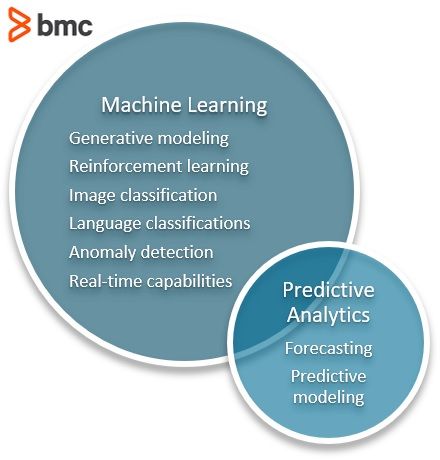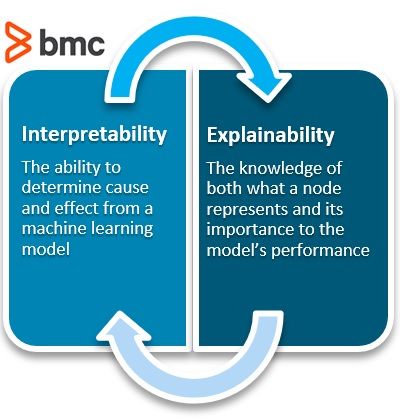Machine Learning and Predictive Analytics approach a problem differently. Eventually, predictive analytics is likely to merge as one application of machine learning.
It’s similar to how the thirsty and the quenched come to the same glass of water. Machine learning is more adaptive, newer, and has larger degrees of freedom, so it can afford to be more flexible with its approach to a problem. Predictive analytics has been around longer and is more procedural in its use.
There is no problem predictive analytics can solve that machine learning cannot. But predictive analytics always has an intended audience, whereas machine learning does not. Let’s explore.

Common use cases for Machine Learning and Predictive Analytics
What is predictive analytics?
Both machine learning and predictive analytics are used to make predictions on a set of data about the future. Predictive analytics uses predictive modelling, which can include machine learning. Predictive analytics has a very specific purpose: to use historical data to predict the likelihood of a future outcome.
At its most basic, analytics of any sort is simply applied mathematics—sometimes known as data science.
Who uses predictive analytics?
The audience of predictive analytics tends to be people, adding an extra level of necessary communication and interpretability to its work. People will ask, “What are Q2 sales going to be?” Predictive analytics answers the question with a degree of confidence.
To Predictive Analysts, machine learning is an extension of their practice, another tool in their toolbox, that helps them to do their job better. Using ML, predictive analysts can:
- Provide answers, with confidence, to more complex problems.
- Offer real-time answers to questions that persist through time with ever-changing data.
- Explore entirely new kinds of problems.
Use cases
predictive analytics is usually conducted on numerical data. Predictive analytics is used to figure out:
- When a sensor might fail
- When to trade a stock
- The chance of success of a marketing campaign
- Employee sentiment
Through the use of machine learning, predictive analytics can expand how it conducts its sentiment analysis to see how happy its customers and employees are.
Machine Learning
Machine learning is different from predictive analytics. Machine learning has less to do with reporting than it does to do with the modelling itself.
Machine learning is the top-shelf tool to conduct statistical analysis. Because of its learning feature, it can fine tune the parameters of its models just right to fit the data. This could take a lot of work if done by hand which would use advanced heteroskedastic methods and other tools by statistics to exclude various data points to fine-tune the parameters of their models.
Machine learning has used algorithms and compute resources to offer an abundance of computation that doesn’t have to spend a lot of time doing the fine-tooth combing through a model’s weights. In part, that is the good and the bad of the machine learning model. The model’s nodes define themselves, so a typical statistician doesn’t have to sift through them. But then, it’s also referred to as a black box because statisticians cannot sift through the nodes and determine what they mean.
Machine learning is a tool used by many companies, on many different kinds of applications. Companies like Microsoft, Amazon, Google, and many others offer machine learning as a service (MLaaS), where data can be submitted to the API and a model is returned. These companies also offer resources and even instruction on how to use machine learning in your application alongside their resources.
Who uses machine learning?
If you notice, nothing in machine learning speaks about an audience. Machine learning wishes to be interpretable. In fact, however, only good models are interpretable. But, unlike predictive analytics, machine learning algorithms do not have to answer a corporation’s major questions. They can, but it is not a requirement of machine learning.

When to use which?
Machine learning is like calculus or physics: it is a tool to be used. Predictive analytics is a role to play that equips itself with tools to accomplish its role—machine learning is one of those tools.
Machine learning doesn’t have to answer people’s questions. Their applications can be created for fun, generating life-like images and seemingly real blog posts. Predictive analytics tends to have a use case in mind, such as business financial predictions and employee satisfaction surveys.
Additional resources
For more on this topic, check out these resources:
- BMC Machine Learning & Big Data Blog
- Machine Learning, Data Science, Artificial Intelligence, Deep Learning & Statistics
- The Role of Predictive Analytics in Cloud Operations
- Top Machine Learning Frameworks To Use in 2020
- Machine Learning with TensorFlow & Keras, a multi-part Guide
- Apache Spark Guide to Machine Learning







